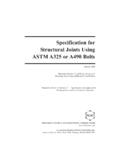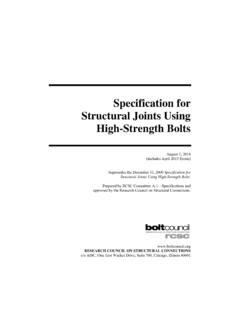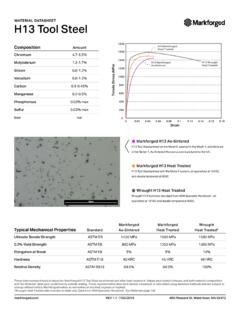Transcription of Specification for Structural Joints Using High-Strength Bolts
1 Specification for Structural Joints Using high - strength BoltsJune 11, 2020 Supersedes the August 1, 2014 Specification for Structural Joints Using High-Strength Bolts Prepared by RCSC Committee Specifications andapproved by the Research Council on Structural COUNCIL ON Structural CONNECTIONSc/o AISC, 130 E Randolph Street, Suite 2000, Chicago, Illinois 60601 Specification for Structural Joints Using high - strength BoltsJune 11, 2020 Supersedes the August 1, 2014 Specification for Structural Joints Using High-Strength Bolts Prepared by RCSC Committee Specifications andapproved by the Research Council on Structural for Structural Joints Using High-Strength Bolts , June 11, 2020 RESEARCH COUNCIL ON Structural CONNECTIONS RCSC 2020byResearch Council on Structural ConnectionsAll rights reserved. This book or any part thereof must not be reproduced in any form with-out the written permission of the information presented in this publication has been prepared in accordance with rec-ognized engineering principles and is for general information only.
2 While it is believed to be accurate, this information should not be used or relied upon for any specific application without competent examination and verification of its accuracy, suitability, and applicability by a licensed professional engineer, designer, or architect. The publication of the material contained herein is not intended as a representation or warranty on the part of the Research Council on Structural Connections or of any other person named herein, that this informa-tion is suitable for any general or particular use or of freedom from infringement of any patent or patents. Anyone making use of this information assumes all liability arising from such must be exercised when relying upon other specifications and codes developed by other bodies and incorporated by reference herein since such material may be modified after the printing of this edition. The Council bears no responsibility for such material it incorpo-rates by reference at the time of the initial publication of this in the United States of America for Structural Joints Using High-Strength Bolts , June 11, 2020 RESEARCH COUNCIL ON Structural CONNECTIONSPREFACEThe purpose of the Research Council on Structural Connections (RCSC) is:(1) To stimulate and support such investigation as may be deemed necessary and valu-able to determine the suitability, strength , and behavior of various types of Structural connections;(2) To promote the knowledge of economical and efficient practices relating to such Structural connections.
3 And(3) To prepare and publish related specifications and such other documents as necessary to achieve its Council membership consists of qualified Structural engineers from academic and research institutions, practicing design engineers, representatives of suppliers and manufacturers of bolting components, steel fabricators, steel erectors, contractors, associations, and code-writing first Specification approved by the Council, called the Specification for Assembly of Structural Joints Using high Tensile Steel Bolts , was published in January 1951. Since that time the Council has published 18 successive editions. Each was developed through the delibera- tions and approval of the full Council membership and based upon past successful usage, advances in the state of knowledge, and changes in engineering design practice. This edition of the Council s Specification for Structural Joints Using High-Strength Bolts continues the tradition of earlier editions.
4 The most significant changes are listed below. 1. Significant additions to Glossary (bolting assembly, bolting component, bolt tension measurement device, calibrated gap, cure, initial tension, initial torque, job inspection gap, matched bolting assembly, spline end, sufficient thread engagement). 2. Discussion of thermal break Joints in commentary. 3. Expanded list of items to be addressed by engineer of record (EOR) in commentary. 4. Addition of 144 ksi, ASTM F3148 matched bolting assemblies. 5. Adoption of Group 120, 144, and 150 to categorize bolt strengths. 6. Short fully threaded Bolts are to be designed with threads in the shear plane. (Table ). 7. Expanded discussion of alternative design bolting components, bolting assemblies, and pretensioning methods ( ). 8. Removed requirement and prohibits hand wire brushing of galvanized faying surfaces in slip-critical Joints . 9. Added ASTM A1059 coating for Added zinc-aluminum coatings, ASTM F2833 and ASTM Expanded discussion of storage and lubrication ( ).
5 12. Moved discussion of reuse to new and expanded section ( ).13. Increased standard bolt hole diameter and slot widths for Bolts 1-in. in diameter and greater (Table ).14. Table Minimum Bolt Pretension moved to Table in Revised values for pre-installation verification testing and for pretension for Group 120 Bolts larger than 1 in. diameter (Table ). Specification FOR Structural Joints Using High-Strength BOLTSS pecification for Structural Joints Using High-Strength Bolts , June 11, 2020 RESEARCH COUNCIL ON Structural CONNECTIONS16. Revised tolerance for turn-of-nut (Table ).17. Corrected figure for DTI installation and washer requirements to agree with specifi-cation (Figure , ).18. Clarified purpose and requirements for pre-installation verification testing (7).19. Provided steps comprising pre-installation verification testing ( ).20. Provided steps for performing pretensioning Using all five methods ( ).
6 21. Added new combined method pretensioning method and inspection requirements for this method ( , ).22. Added instructions for determining required rotation when bolt length exceeds 12 bolt diameters ( commentary).23. Restricted the use of calibrated wrench pretension method to rotation of the nut ( ).24. Clarified numbers of gaps permitted and required for DTI pretensioning and inspec-tion ( , ).25. Added reference to AISC Specification for Structural Steel Buildings Chapter N, Added essential variables to Appendix A slip coefficient Added effective period for slip resistance test addition, many editorial changes to the 2014 publication of the Specification are reflected in this latest Council wishes to express their gratitude to Gian A. Rassati for his extensive and dili-gent work managing the changes through many revisions and multiple ballots.
7 His service to the Council has been extraordinary and was instrumental for publication of this edition of the the Research Council on Structural Connections,OfficersSalim V. Brahimi Robert Shaw Jonathan McGormley Chair Vice Chair Secretary/TreasurerDirectorsToby Anderson Carly McGee Thomas J. SchlaflyCurtis L. Mayes Gian A. Rassati Todd C. UdeTask Groups1 General Requirements Gian A. Rassati2 Products and Parts Toby Anderson3 Design James A. Swanson4 Installation Heath E. Mitchell/Chad M. Larson5 Inspection Daniel J. Kaufman for Structural Joints Using High-Strength Bolts , June 11, 2020 RESEARCH COUNCIL ON Structural CONNECTIONSC ommitteesA1 Specification Larry F. KruthA2/A4 Research, Education and Projects Todd C. UdeA3 Membership and FundingA5 Organizational Liaison Salim V. BrahimiB Editorial Thomas J. Schlafly Staff Support Rachel JordanMembersRodney L. Baxter Philip A. Goldsby Brad PorterJason Bell Brian Goldsmith Randy ReaganPeter C.
8 Birkemoe Matthew Haaksma Jordan RichardsonDavid Bogaty Jerome F. Hajjar Joseph T. RidgwayDavid Bornstein Robert A Hay III Sougata RoyRich Brown Charles J. Kanapicki Jeremy RuggioGarret O. Byrne Peter F. Kasper Michael SamuelsChad T. Case Daniel J. Kaufman Ben SeinolaDerrick Castle James S. Kennedy Rachel ShanleyJason Chadee Thomas J. Langill David F. SharpHelen Chen Chad M. Larson Victor ShneurRobert J. Connor Donald Livi W. Lee ShoemakerBastiaan Cornelissen Mike Marian Nicholas SovellChris Curven John C. Marvin Mritunjaya SrivastavaNick E. Deal Ronnie Medlock Carlos Suarez GullardoDouglas B. Ferrell Jinesh K. Mehta James A. SwansonJohn W. Fisher Heath E. Mitchell Thomas S. Tarpy, H. Frank Thomas M. Murray Chris ThorsenMichael C. Friel James Neeley Raymond TideChristopher Garrell Christian Noveral Carmen VertulloAlbert Gelles Justin Ocel Dan WrobleskiBill Germuga Sarah Olthof Natasha ZamaniRodney D. Gibble Anna for Structural Joints Using High-Strength Bolts , June 11, 2020 RESEARCH COUNCIL ON Structural CONNECTIONSTABLE OF CONTENTSSYMBOLS.
9 ViiiGLOSSARY.. xSection 1. General Requirements .. Scope .. Loads, Load Factors, and Load Combinations .. Design for strength Using Load and Resistance Factor Design (LRFD) .. Design for strength Using Allowable strength Design (ASD) .. Referenced Standards and Specifications .. Structural Design Drawings and Specifications .. 5 Section 2. Bolting Components and Assemblies .. Group Designations .. Heavy Hex Structural Bolts .. Heavy Hex Nuts .. Spline End Matched Bolting Assemblies.. Washers .. Washer-Type Indicating Devices .. Geometry of Bolting Components and Assemblies .. Galvanized and Coated Bolting Components and Assemblies .. Test Reports .. Storage and Lubrication .. Reuse .. Alternative-Design Bolting Components, Assemblies, and Methods .. 20 Section 3. Bolted Parts .. Connected Plies .. Faying Surfaces .. Bolt Holes .. Burrs .. 31 Section 4.
10 joint Type .. Snug-Tightened Joints .. Pretensioned Joints .. Slip-Critical Joints .. 35 Section 5. Limit States in Bolted Joints .. Nominal Shear and Tensile Strengths .. Combined Shear and Tension .. Nominal Bearing strength at Bolt Holes .. Design Slip Resistance .. Tensile Fatigue .. 48 cation for Structural Joints Using High-Strength Bolts , June 11, 2020 RESEARCH COUNCIL ON Structural CONNECTIONSS ection 6. Use of Washers .. 496 .1 . Snug-Tightened Joints Using Group 120, 144, or 150 Bolting Assemblies .. 496 .2 . Pretensioned Joints and Slip-Critical Joints Using Group 120, 144, or 150 Bolting Assemblies .. 49 Section 7. Pre-Installation Verification .. 527 .1 . Required Testing .. 527 .2 . Test Procedure .. 54 Section 8. Installation .. 608 .1 . Snug-Tightened Joints .. 608 .2 . Pretensioned Joints and Slip-Critical Joints .. 61 Section 9. Inspection ..709 .1 . Snug-Tightened Joints .












